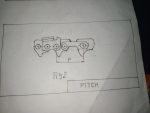I’ve been sharpening chainsaws for many years, and l’ve noticed that most owners don’t perform basic maintenance on their equipment. They don’t even know what maintenance they should perform after use, such as cleaning, oiling, and unclogging the chain’s lubrication holes.
The file that comes with a manufacturer’s chainsaw kit is used to maintain the correct sharpening angle. Not all chains are sharpened to a 30° angle. For example, the Ripping Chaín used in some portable sawmills has a cutting angle of just 10°.
If you don’t know which file dimension to use according to the pitch of the chain, then consult the following table:
| Chainsaw Pitch Measurement | Appropriate File Size |
| 6.35 mm or 1/4″ | 4.0 mm or 0.157” |
| 8.25 mm or .325” | 4.8 mm or 0.188” |
| 9.525 mm or 3/8″ | 5.2 mm or 0.204” |
| 10.26 mm or .404” | 5.5 mm or 0.216” |
Table 1
Something that many owners don’t often do is check the chain’s depth gauge, because with successive sharpenings it often remains higher than the top plate, making the chain less efficient at cutting.
The height of the depth gauge in the example is .025″. The equivalent in millimeters is 0.05 mm. This is measured with a caliper. If it exceeds this height, then it should be lowered with a flat file.
Chainsaw sharpening equipment Is relatively low-cost. The problem is that not every saw owner knows that they should acquire it or how to properly use it. Most find it easier to take their dull chains to a chainsaw shop with a service department for maintenance.
Fig.1 shows the parts of a Chaín Cutter.
When we acquire a new chaín, we must obtain certain information including the brand of our equipment, the pitch, length of the bar, thickness of the drive link and most importantly the manufacturer’s part number. Of these, the part number is crucial since that determines what it is the right one for our equipment.
The thickness of the drive links is measured with a slide caliper. The most common thicknesses are listed in Table 2:
| Drive Link Thickness (Inches) | Drive Link Thickness (Millimeters) |
| .043″ | 1.2mm |
| .050″ | 1.3mm |
| .058″ | 1.5mm |
| .063″ | 1.6mm |
Table 2
Chain Pitch
The pitch is the distance between the consecutive rivets. (See Figure 2.) It should be measured with a slide caliper and then divided by two.

Some common pitches of chainsaw chains is summarized in Table 3.
| Pitch Measurement (Inches) | Pitch Measurement (Millimeters) |
| 1/4″ | 6.35 |
| 3/8″ Low Profile | 9.52 |
| .325 | 8.25 |
| 3/8″ Regular Profile | 9.52 |
| .404 | 10.25 |
Table 3
When using either a hobby chaín grinder or a professional sale chaín grinder, the chain pitch must be taken into account, for 1/4″, 3/8 LP, .325″ the grinding wheels have a thickness of 3.2 millimeters, or approximately .125″. And for regular 3/8″ and .404″ grinding wheels must be 4.8 millimeters or approximately .188″.
The chain cutter has marks on the top plate. The last mark indicates how far the chain can be sharpened. Once that last mark is reached, the chain must be scrapped and replaced.
SOME THOUGHTS
To assume that SurvivalBlog Is only read in the USA is a somewhat shortsighted view of the survival movement. That is why I included the metric system. Those of us who did vocational training, especially those of the old school, are more practical in our work using the Imperial system. (Or English system, as one of my teachers called it). I suppose that since the two main brands of gardening and tree service tools (Stihl and Husqvarna) are European, the metric system predominates, since even the clones are millimetric. I was surprised that the screw pitch is also metric! Well, in my youth, it was common to own two sets of tools, one metric and the other SAE (Society of American Engineers). The Internet allows us to purchase tools and spare parts from anywhere in the world, and have them delivered to our doorsteps.
Chainsaws have many critical parts, not just the cutting chain.
A spark plug that doesn’t work is useless. How many of us have a spare spark plug or a carburetor kit compatible with our equipment?
I must also mention analog measuring instruments, especially the less common ones like micrometers, where if the reading wasn’t exact, you had to subtract thousandths. Many will say that level of precision is not that important. But if someone is supposed to repair the engine of a chainsaw or generator and tells you that you need a new crankshft then you’ll surely want to know their criterion for requesting approval for such a major expense!
Having a well-equipped workshop allows you to perform tasks more efficiently. But having the knowledge will allow you to solve difficult situations even if you don’t have the specific equipment. A well-stocked library is essential for troubleshooting specific problems.
Read the full article here

